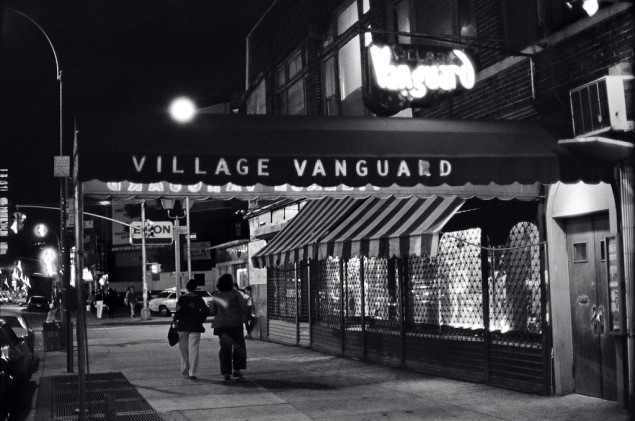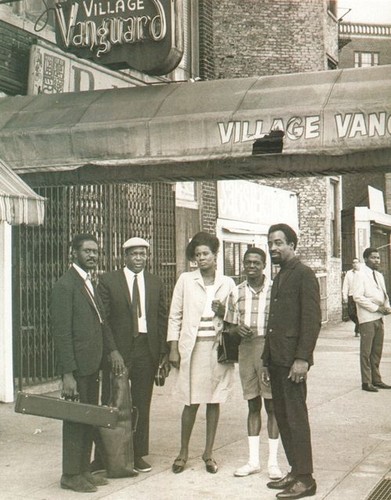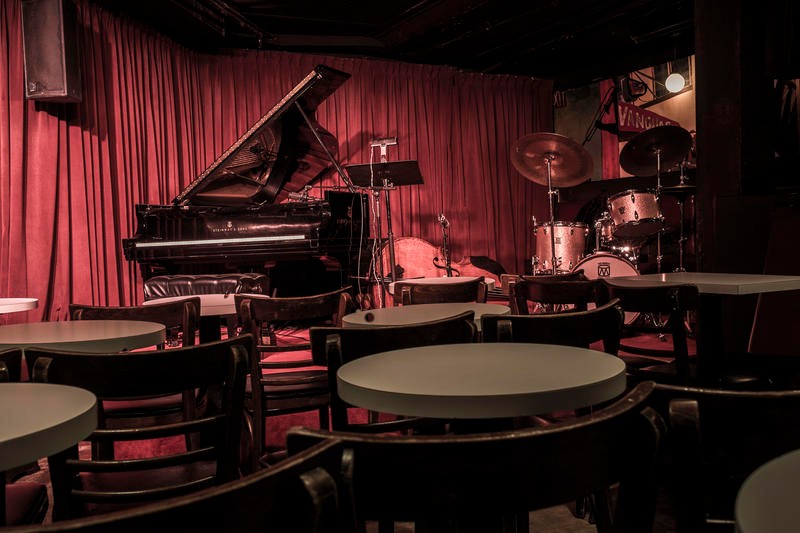The Village Vanguard
Introduction
Text-to-speech Audio
Images
The Village Vanguard in the 1970s

Pharoah Sanders, John Coltrane, Alice Coltrane, Jimmy Garrison, and Rashied Ali outside the Village Vanguard

The club's interior

Backstory and Context
Text-to-speech Audio
Max Gordon, a Lithuanian immigrant, opened the first Village Vanguard in 1934 on Greenwich Avenue. The following year, he opened a new Village Vanguard at its current location, in a small, triangle-shaped basement on Seventh Avenue South. In the near century since its opening, the legendary club remains largely as it was in 1935.
Gordon appreciated talent in many forms, and the club was founded with the intention of hosting poetry readings and folk music. In the 1940s, however, the club began to host primarily jazz acts and within a few years it developed a reputation largely as a jazz venue. Gordon was a kind and welcoming presence and genuinely supported the young musicians who performed at the club. Over the years, a number of aspiring musicians got their start at the Village Vanguard, including Harry Belafonte and Judy Holliday.
As the popularity of jazz grew, so did the popularity of the club. By mid-century, the Village Vanguard was attracting some of the biggest names in the business. Among the giants who have performed there: Thelonius Monk, Miles Davis, Charlie Mingus, and Sonny Rollins. But the Village Vanguard isn't only a venue for performances; many of the greats of the genre have recorded there as well. The first of these was Sonny Rollins's "A Night at the Village Vanguard," recorded in 1957 and now regarded as one of the classic jazz recordings. Over the course of week in 1961, John Coltrane recorded "Live at the Village Vanguard," another hallowed addition to the jazz canon.
Max Gordon, who was in the audience virtually every night the club was open, died in 1989. His widow, Lorraine, closed the cl/ub for exactly one night before reopening and carrying on with business. Her own eye for talent was as sharp as her husband's and she continued operating the club until her death in 2018. The Gordons' daughter, Deborah, now oversees the legendary venue, which remains largely unchanged from the time her father opened it in 1935.
Sources
Watrous , Peter . Max Gordon, 86, Jazz Promoter and Founder of Vanguard, Dies , New York Times . May 12th 1989. Accessed September 13th 2020. https://www.nytimes.com/1989/05/12/obituaries/max-gordon-86-jazz-promoter-and-founder-of-vanguard-dies.html.
Chinen, Nate . Still Searching, Still Chasin': John Coltrane's Village Vanguard Recordings , Jazz Times . April 26th 2019. Accessed September 13th 2020. https://jazztimes.com/features/columns/still-searching-still-chasin-john-coltranes-village-vanguard-recordings/.
Fleischmann, Laura . The Hallowed Music Halls of the Greenwich Village Historic District , Greenwich Village Society for Historic Preservation . May 8th 2019. Accessed September 13th 2020. https://gvshp.org/blog/2019/05/08/hallowed-halls-greenwich-village-historic-district/.
The Village Vanguard: A Hallowed Basement , NPR . August 27th 2008. Accessed September 13th 2020. https://www.npr.org/2008/08/27/94034531/the-village-vanguard-a-hallowed-basement.
